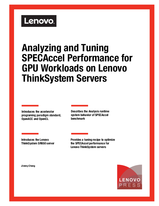Author
Published
24 May 2019Form Number
LP1146PDF size
24 pages, 228 KBAbstract
The use of GPU high-performance accelerators are especially important in High Performance Computing (HPC) workloads. As a result, it is critical to ensure that the GPUs provide the most processing power possible by adjusting key performance and measuring the results.
The SPECAccel benchmark uses the OpenCL and OpenACC programing paradigm to provide a comparative measure of parallel computing performance among systems equipped with an accelerator. Through runtime characteristic analysis, this paper provides a best practices recipe for Lenovo® ThinkSystem™ servers to obtain the best performance for GPU workloads, as well as other applications that have characteristics similar to the SPECAccel benchmark.
This paper is intend for ThinkSystem end users and technical sales representatives who want to understand how to tune GPU performance. The paper assumes readers are familiar with Linux and have basic experience with programming languages such as C/C++.
Table of Contents
Introduction
Accelerator Programing Paradigm
SPECAccel benchmark
ThinkSystem SR650
Analysis of CPU performance
Analysis of memory performance
Analysis of PCIe performance
Analysis of NVIDIA V100 GPU performance
Performance tuning
Performance world records
Conclusion
To view the document, click the Download PDF button.
Configure and Buy
Full Change History
Course Detail
Employees Only Content
The content in this document with a is only visible to employees who are logged in. Logon using your Lenovo ITcode and password via Lenovo single-signon (SSO).
The author of the document has determined that this content is classified as Lenovo Internal and should not be normally be made available to people who are not employees or contractors. This includes partners, customers, and competitors. The reasons may vary and you should reach out to the authors of the document for clarification, if needed. Be cautious about sharing this content with others as it may contain sensitive information.
Any visitor to the Lenovo Press web site who is not logged on will not be able to see this employee-only content. This content is excluded from search engine indexes and will not appear in any search results.
For all users, including logged-in employees, this employee-only content does not appear in the PDF version of this document.
This functionality is cookie based. The web site will normally remember your login state between browser sessions, however, if you clear cookies at the end of a session or work in an Incognito/Private browser window, then you will need to log in each time.
If you have any questions about this feature of the Lenovo Press web, please email David Watts at dwatts@lenovo.com.

